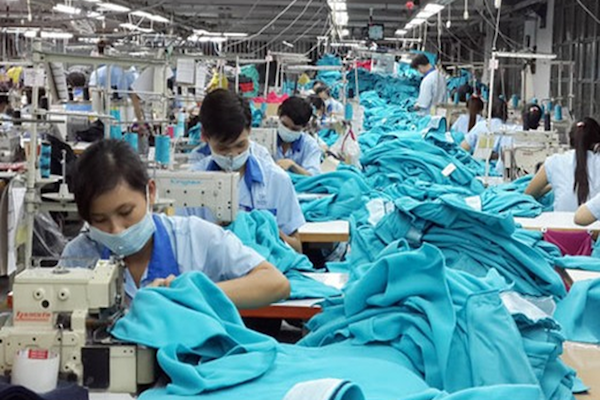With the successful control of the epidemic, highly appreciated by the international community, along with an increasingly improved investment environment, Vietnam is considered a destination for many foreign capital flows after the Covid-19 pandemic.
The textile and garment industry contributes nearly 40 billion USD to exports, attracting billions of dollars in foreign direct investment (FDI), but according to many assessments, the movement of investment capital flows to Vietnam in textile industry is there, but not at this time.
![]()
Groundbreaking ceremony for the construction of the Fortunate Vietnam garment factory project took place in late July.
Looking at reality shows that, compared to 2019, FDI in this industry has decreased significantly and the lack of major projects. Most recently in July 2020, Fortunate Fashion Hong Kong Vietnam Co., Ltd. started the Fortunate Vietnam Garment Factory Project. The project specializes in producing fashion and garment products in Tay Ninh with the scale of 19.2 million products / year.
In addition, at the end of May 2020, Texhong Knitting Company Limited (Hong Kong) was granted the certificate of investment registration by the Management Board of Quang Ninh Economic Zone to implement the Knitting Factory Project in Texhong Hai Industrial Park. Ha.
The project is implemented on a land area of more than 249,900 m2, with the goal of producing knitted fabrics. The total investment capital of the project is over 4,979 billion VND, equivalent to 214 million USD. The project needs to use more than 2,700 workers. As planned, by the end of 2021, the first phase of the project will be put into operation, phase 2 will be completed and put into operation 20 months later.
In February 2020, Brotex (Vietnam) Co., Ltd. also started the project of Brotex Spinning Factory Zone C - phase 4 in Phuoc Dong Industrial Park (Go Dau district, Tay Ninh province) ...
Obviously, although there are also FDI projects in Vietnam in the first months of 2020, the wave of investment shift in the textile and garment industry has not happened when the global demand for textiles and clothing has not increased, market movements are still difficult. guess.
Meanwhile, in 2019, although the export market is more or less affected by the US-China trade tensions, the 5 countries and territories with the largest amount of investment in the textile and garment industry are Hong Kong ( 447 million USD), Singapore (370 million USD), China (270 million USD), South Korea (165 million USD), Seychelles (103 million USD).

Currently, Vietnam only meets the domestic market from 47 - 48% and with the increase in investment mobility of other countries, the industry may increase to 67 - 68% in the coming time.
Although there are no specific statistics like 2019, but looking at the number of FDI in Vietnam in the past 8 months shows that the textile and garment industry will not be out of that general trend. Accordingly, in the eight months of 2020, according to the Foreign Investment Department (Ministry of Planning and Investment), the total newly registered FDI capital, adjusted and contributed capital to buy shares of foreign investors reached 19.54 billion USD, down 13.7% over the same period in 2019.
Mr. Le Tien Truong, Chairman of Vinatex said, “At this time, it is unreasonable to talk about investing in large projects, especially for the textile and garment industry, because the market demand is already there. Large markets that consume textiles and garments such as the US, EU are still struggling against epidemics, purchasing power has not increased again ... When the demand for goods is low, it is difficult for investors to talk about investment promotion. out".
According to the Chairman of the Textile and Apparel Association Mr. Vu Duc Giang, previously Japan, Korea, Taiwan and China were considered as the leading textile "powers" in the world, but at present, countries and territories this is decreasing in production, due to the effects of the Covid-19 pandemic. Therefore, the transfer of production to other countries, including Vietnam, is inevitable.
"Cash flow will flow in when the disease is controlled or vaccines are available, market demand goes up - factors that ensure that the capital of investors is preserved," said Mr. Le Tien Truong.
Vietnam is a market with many free trade agreements (FTAs) with other countries - which will create many opportunities for this investment shift.
The movement of production by foreign investors will support Vietnam's textile and apparel to increase the proportion of the supply shortage. At that time, domestic enterprises will increase the proportion of localization, and will enjoy investment incentives as committed from free trade agreements.
Currently, Vietnam only meets the domestic market from 47 - 48% and with the increase in investment mobility of other countries, the industry may increase to 67 - 68% in the coming time.
http://tapchitaichinh.vn/tai-chinh-kinh-doanh/von-fdi-than-trong-vao-det-may-327948.html
Source: tapchitaichinh.vn